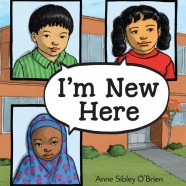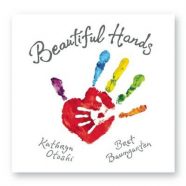Start your new year off with compassion
This is a post I’ve shared before but I think it’s more important than ever to make your classroom a place of acceptance and compassion from day one.
It’s September, the start of a new school year. I have no apples for you teachers, but I do have the perfect back-to-school picture book to teach empathy and point of view: I’m New Here by Anne Sibley O’Brien.
Maria, Jin, and Fatimah are new to their schools and to the United States. Through their stories, we get a glimpse of what it’s like to hear a new language, to see a new alphabet, and to try to pick up a new set of classroom expectations. “Back home… I knew just what to do.” All of your students can relate to the unsettled feeling of a first day in a new classroom. With I’m New Here, you can expand upon that feeling to help your students empathize with people who are new to our country. I love that Anne Sibley O’Brien not only shows what it’s like to be an immigrant, but how we all learn from each other. On one page, O’Brien writes from Jin’s point of view, “I am learning from others. And they are learning from me.” Jin asks a little boy, “How to spell cloud?” The boy responds, “C-L-O-U-D.” Jin holds up a piece of paper with Korean characters on it. “This is cloud in Korean.” “Cool.”
Michelle A., a gifted kindergarten teacher of English as a Second Language students and a remarkable friend, told me about Step Inside thinking. After you’ve read through the book, ask your students to “step inside” a character and imagine that they are Maria, Jin, or Fatimah. Students can write and draw from the perspective of the character, describing what was a challenge and what helped. You can turn this book into a readers’ theater script for students to perform, or have students take on the roles in an impromptu performance as you reread the book. As a class, you can talk and write about what you all can do to help a new student feel welcome. Whether or not you gain a new student during the year, all of your students will gain a wider, more empathetic perspective from I’m New Here.
Read MoreCelebrate all the BEAUTIFUL HANDS!
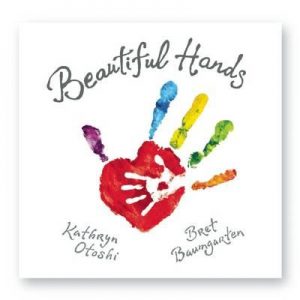 August is crazy-busy for teachers and parents of little learners, so grab this book for a quick-prep, interactive lesson: BEAUTIFUL HANDS by Kathryn Otoshi and Bret Baumgarten.
August is crazy-busy for teachers and parents of little learners, so grab this book for a quick-prep, interactive lesson: BEAUTIFUL HANDS by Kathryn Otoshi and Bret Baumgarten.
The book begins with a question, “What will your beautiful hands do today?” which leads to more questions with inspiration-sparking answers:
“Will they lift…/
spirits?/
Or stretch…/
imaginations?”
There are also invitations to participate (“What can you lift?” “What can you stretch?”) that will especially hook your movers and shakers.
All of the art is made of handprints, so after sharing the book, make handprint art! Paint, trace, color, cut, arrange into a mural that encourages us all to reach high. Write about what our hands can and will do, discuss how our hands are alike and still uniquely ours. Reread BEAUTIFUL HANDS and compare it to the book THE HANDIEST THINGS IN THE WORLD by Andrew Clements and Raquel Jaramillo. 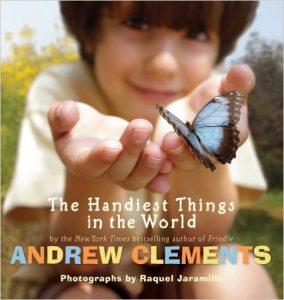
All who work with little ones deserve a big hand, so consider this post a “high five” from me to you as you start the school year!
Read MoreSeptember Bonus List of Books and Activities!
Because I gave a presentation to awesome librarians this month and I couldn’t resist sharing all the great ideas we came up with, you get a bonus post this month! And because you’re getting a bonus post, I hope you’ll allow me to indulge in a bit of horn-tooting.
My debut picture book, GROUNDHOG’S DILEMMA, illustrated by Matt Faulkner (swoon!) will be published by Charlesbridge this December 1st, and it recently received a good professional review:
“Faulkner’s anthropomorphic animals and vibrant colors recall Uncle Wiggly, and the illustrations are packed with humorous details that repay rereadings. Remenar’s graceful prose and the subtlety of her message, pitched to older preschoolers and early-elementary students, are a good match. A sly and funny take on truth-telling and friendship.” – Kirkus, Oct. 2015
Woohoo!!!!!!!
Ok, horn-tooting over.
I spent a morning with a roomful of youth librarians and bunches of new books. We came up with these activities revolving around the key early literacy skills: Talk, Sing, Read, Write, Play. (Look here for lots more good stuff from Every Child Ready to Read.) Many of our activities can be used with a variety of books. I’m including our list of ideas and the books we shared. Enjoy!
TALK:
* Read Rufus Goes to School by Kim T. Griswell and talk about what you need for school, what you shouldn’t do in school, and favorite books you know how to read.
* Read Groundhog’s Dilemma by Kristen Remenar and talk about your favorite/least favorite parts of winter and spring. Talk about animals that hibernate and those that don’t. Talk about why the characters in the story wanted or didn’t want Groundhog to see his shadow.
* Read Clothesline Clues to Sports People Play by Andy Robert Davies and encourage kids to guess the sport. Discuss unfamiliar terms like foil and quiver.
* Use nonfiction books with photos of bees to go along with Bee Dance by Rick Chrustowski. Bring in a honeycomb and give kids bendy straws so they can act like the bees in the book.
* Read Pepper and Poe by Frann Preston-Gannon and discuss why Pepper feels the way he does.
* Discuss good and bad manners after reading The Entertainer by Emma Dodd.
* Encourage kids to respond to “which would you choose?” while reading Hot Rod Hamster by Cynthia Lord.
SING:
* Sing rhyming words, even nonsense ones, after reading Hi! by Ethan Long.
* Sing “Milkshake” after reading Lulu’s Party by Kit Chase.
* Sing the book Old Mikamba Had a Farm by Rachel Isadora.
* Sing “The Days of the Week” song after reading Pepper and Poe by Frann Preston-Gannon, or “If You’re Happy and You Know It”.
* Sing “Take Me Out to the Ball Game” after reading Groundhog’s Dilemma by Kristen Remenar.
READ:
* Read nonfiction books about groundhogs and Groundhog’s Day along with Groundhog’s Dilemma by Kristen Remenar. (It delights me every time I type it!) Use puppets to help narrate/read the story.
* Use magnetic or felt letters to rearrange and read aloud, after reading Little Bird’s Bad Word by Jacob Grant.
WRITE:
* Kids can decorate the first letter of their name or make pictures with die-cut letters after reading Alphabeasties by Sharon Werner and Sarah Forss.
* Write your own “wumbers” inspired by Wumbers by Amy Krouse Rosenthal and Tom Lichtenheld.
* Draw or write about something you cherish after reading Thankful by Eileen Spinelli.
* Trace your shoes and decorate the tracings after reading Whose Shoe? by Eve Bunting.
* Write a letter or draw a picture to convince Groundhog to predict winter or spring after reading Groundhog’s Dilemma by Kristen Remenar. Kids can write and draw about a time when they’ve had to resolve a dilemma. Outside with chalk, or inside on paper, kids can trace their own shadows!
* Create maps of your playground, classroom, school, library, etc. after reading Henry’s Map by David Elliot.
* Paint Q-tip paintings of trees inspired by Fall is Not Easy by Marty Kelley.
* Write your own “word equations” inspired by This Plus That by Amy Krouse Rosenthal.
PLAY:
* Use a string and pin it to a world map to show all the places from Because Amelia Smiled by David Ezra Stein. Compare it to Madlenka and Nothing Ever Happens on My Block.
* Act out Uh Oh! by Shutta Crum.
* Play a version of “Going On a Bear Hunt” after reading In the Canyon by Liz Garton Scanlon.
* Incorporate different dances like The Hokey Pokey and The Twist and act out The Sky Is Falling by Mark Teague. Have a dance party!
* Create hand/body motions and make the sound effects for Niňo Wrestles the World by Yuyi Morales. Come up with other characters who might want to wrestle!
* Move like cats and act out the emotions from Pepper and Poe by Frann Preston-Gannon.
* Have a storytime party where kids act out what should and should not happen at a party after reading The Entertainer by Emma Dodd.
* Paint small boxes like houses after reading Vincent Paints His House by Tedd Arnold.
* Rearrange letter tiles to show how one word can become another after reading One Boy by Laura Vaccaro Seeger.
* Act out Groundhog’s Dilemma by Kristen Remenar. (Still fun to type!) Little ones can curl up in a box and pop out for Groundhog’s Day to look for their shadows, or try making shadow animals on a wall.
The winner is: You Are (Not) Small!
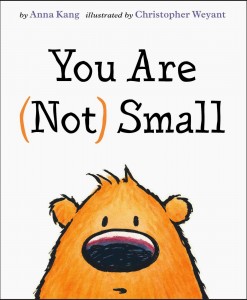 Happy Book Award Season! Many of us look forward to the annual announcement of the Caldecott and Newbery Medal Awards from the American Library Association, but the one that made me hoot and holler loudest this year was the announcement of the winner of the Theodor Seuss Geisel Award for the most distinguished beginning reader book: You Are (Not) Small written by Anna Kang and illustrated by Christopher Weyent.
Happy Book Award Season! Many of us look forward to the annual announcement of the Caldecott and Newbery Medal Awards from the American Library Association, but the one that made me hoot and holler loudest this year was the announcement of the winner of the Theodor Seuss Geisel Award for the most distinguished beginning reader book: You Are (Not) Small written by Anna Kang and illustrated by Christopher Weyent.
Fantastic “easy” reader? Check.
Great for Readers’ Theater? Check.
Funny ending? Check.
Works for a ton of tie-in lessons? Check.
Story and art that kids will want to return to again and again? Big ol’ check!
Finding mentor texts on expressing opinion, giving reasons, persuasion, etc. isn’t easy for the younger crowd, so if you teach kindergarten – third grade, grab You Are (Not) Small. (It’s also fantastic for a print concepts lesson on italics, ellipses, underlining, for a lesson on reading with expression, for a math/science tie-in for comparing items by size, but I digress.)
The two main characters in this book express clear, opposite opinions. The orange fuzzy creature tells the purple fuzzy creature, “You are small.” The purple fuzzy disagrees, “I am not small. You are big.” Back and forth they go, giving reasons for their opinion by comparing themselves to other fuzzy creatures. It’s so simple it’s brilliant, and the ending will get everyone giggling.
After reading this to a first grade class, I told them, “You are small.” Uproar ensued. “No, we aren’t!”
“Yes, my opinion is that you are small, and my reason is that you are all smaller than this bookshelf.”
“But we’re bigger than the chair!” “Yes, and we’re taller than the desk!”
This led to an easy quick-write session: choose an opinion statement of “I am big” or “I am small” and write three reasons to support your opinion. Go!
So grab You Are (Not) Small by Anna Kang and Christopher Weyant, and check out other winners of the Theodor Seuss Geisel Award. The Caldecott and Newbery Medals are wonderful, but they aren’t the only awards given by ALA, so explore lists like the Coretta Scott King Awards and treat yourself to award-winning books.
Read More




